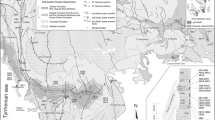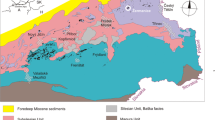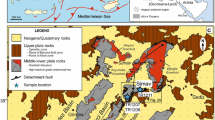Abstract
The 1.8–1.7 Ga Eidsfjord Anorthosite Complex on Langøy, Vesterålen, north Norway is thrust over monzonitic gneisses in a 100-m-wide fault zone. The anorthosite contains abundant pseudotachylite which also overprint ductilely formed (ultra)mylonites in the monzonitic gneisses. 40Ar–39Ar dating of the pseudotachylites indicates that this deformational event took place during the end of the Caledonian orogeny. Pseudotachylite formation by in-situ melting is corroborated by a detailed petrological investigation of chemical and textural criteria. Identity of host-rock mineral compositions and modes with pseudotachylite clasts and calculated modes confirm the common notion that transport over more than a few cm did not occur during pseudotachylite formation, because the characteristics of the host rocks are inherited by the pseudotachylite. Pseudotachylite compositions lie in the range of XRF whole-rock analyses of deformed and undeformed host rocks, demonstrating that no material was added or lost during pseudotachylitisation. The pseudotachylites show strong chemical heterogeneity on a scale of tens of micrometers. This compositional variation can be described by an approximately binary mixture of plagioclase with a homogenised mafic component, comprising orthopyroxene, clinopyroxene and Fe–Ti oxides. Although the pseudotachylite matrix is not homogenised and locally shows schlieren textures, the mafic phase in the anorthositic rocks must have homogenised very well before incorporation into the pseudotachylite. Different viscosities and mixing properties for the Al- and the Fe-rich parts of the pseudotachylite melt are inferred.
















Similar content being viewed by others
References
Allen AR (1979) Mechanism of frictional fusion in fault zones. J Struct Geol 1:231–243
Armstrong JT (1991) Quantitative elemental analysis of individual microparticles with electron beam instruments. In: Heinrich KFJ, Newbury DE (eds) Electron probe quantification. Plenum Press, New York, pp 261–315
Asimow PD, Ghiorso MS (1998) Algorithmic modifications extending MELTS to calculate subsolidus phase relations. Am Mineral 83:1127–1132
Austrheim H, Boundy TM (1994) Pseudotachylytes generated during seismic faulting and eclogitization of the deep crust. Science 265:82–83
Caroll MR, Stolper EM (1993) Argon solubility in silicate melts and glasses: new experimental results for argon and the relationship between solubility and ionic porosity. Geochim Cosmochim Acta 57:5039–5051
Elkins LT, Grove TL (1990) Ternary feldspar experiments and thermodynamic models. Am Mineral 75:544–559
Ghiorso MS, Sack RO (1995) Chemical mass transfer in magmatic processes. 4. A revised and internally consistent thermodynamic model for the interpolation and extrapolation of liquid-solid equilibria in magmatic systems at elevated temperatures and pressures. Contrib Mineral Petrol 119:197–212
Griffin WL, Taylor PN, Hakkinen JW, Heier KS, Iden IK, Krogh EJ, Malm O, Olsen KI, Ormaasen DE, Tveten E (1978) Archaean and Proterozoic crustal evolution in Lofoten-Vesterålen. J Geol Soc Lond 135:629–647
Grocott J (1981) Fracture geometry of pseudotachylyte generation zones: a study of shear fractures formed during seismic events. J Struct Geol 3:169–178
Hames WE, Andersen A (1996) The timing of Paleozoic orogeny and extension in the continental shelf of north-central Norway as indicated by laser 40Ar/39Ar muscovite dating. Geology 24:1005–1008
Harrison TM, Heizler MT, Lovera OM, Chen W, Grove M (1994) A chlorine disinfectant for excess argon released from K-feldspar during step heating. Earth Planet Sci Lett 123:95–104
Heier KS (1960) Petrology and geochemistry of high-grade metamorphic and igneous rocks on Langøy, northern Norway. Norges Geol Unders Bull 207
Klein AC, Steltenpohl MG, Hames WE, Andersen A (1999) Ductile and brittle extension in the southern Lofoten archipelago, northern Norway. Am J Sci 299:69–89
Krogh EJ (1977) Origin and metamorphism of iron formations and associated rocks, Lofoten-Vesterålen, northern Norway. 1.The Vestpolltind Fe-Mn deposit. Lithos 10:243–255
Lin A (1999) Roundness of clasts in pseudotachylytes and cataclastic rocks as an indicator of frictional melting. J Struct Geol 21:473–478
Løseth H, Tveten E (1996) Post-Caledonian structural evolution of the Lofoten and Vesterålen offshore and onshore areas. Norsk Geol Tidsskrift 76:215–230
Macaudiere J, Brown WL (1982) Transcrystalline shear fracturing and pseudotachylite generation in a meta-anorthosite (Harris, Scotland). J Struct Geol 4:395–406
Macaudiere J, Brown WL, Ohnenstetter D (1985) Microcrystalline textures resulting from rapid crystallization in a pseudotachylite melt in a meta-anorthosite. Contrib Mineral Petrol 89:39–51
Maddock RH (1983) Melt origin of fault-generated pseudotachylytes demonstrated by textures. Geology 11:105–108
Maddock RH (1992) Effects of lithology, cataclasis and melting on the composition of fault-generates pseudotachylites in Lewisian gneiss, Scotland. Tectonophysics 204:261–278
Magloughlin JF (1992) Microstructural and chemical changes associated with cataclasis and frictional melting at shallow crustal levels: the cataclasite-pseudotachylyte connection. Tectonophysics 204:243–260
Magloughlin JF, Spray JG (1992) Frictional melting processes and products in geological materials: introduction and discussion. Tectonophysics 204:197–204
Malm O, Ormaasen DE (1978) Mangerite-charnockite intrusions in the Lofoten-Vesterålen area, North Norway; petrography, chemistry and petrology. Norges Geol Unders Bull 338:83–114
Markl G (1998) The Eidsfjord anorthosite, Vesterålen, Norway: field observations and geochemical data. Norges Geol Unders Bull 434:53–75
Markl G, Bucher K (1997) Proterozoic eclogites from the Lofoten islands, northern Norway. Lithos 42:15–35
Markl G, Frost BR (1999) The origin of anorthosites and related rocks from the Lofoten islands, northern Norway. II. Calculation of parental liquid compositions for anorthosites. J Petrol 40:61–77
Markl G, Frost BR, Bucher K (1998) The origin of anorthosites and related rocks from the Lofoten islands, northern Norway. I. Field relations and estimation of intrinsic variables. J Petrol 39:1425–1452
McDougall I, Harrison TM (1999) Geochronology and thermochronology by the 40Ar/39Ar method. Oxford University Press
Mitchell JN, Scoates JS, Frost CD, Kolker A (1996) The geochemical evolution of anorthite residual magmas in the Laramie Anorthosite Complex, Wyoming. J Petrol 37:637–660
O'Hara K (1992) Major- and trace-element constraints on the petrogenesis of fault-related pseudotachylite, western Blue Ridge province, North Carolina. Tectonophysics 204:279–288
O'Hara KD, Sharp ZD (2001) Chemical and oxygen isotope composition of natural and artificial pseudotachylite: role of water during frictional fusion. Earth Planet Sci Lett 184:393–404
Olesen O, Torsvik TH, Tveten E, Zwaan KB, Løseth H, Henningsen T (1997) Basement structure of the continental margin in the Lofoten-Lopphavet area, northern Norway: constraints from potential field date, on-land structural maping and palaeomagnetic data. Norsk Geol Tidsskrift 77:15–30
Olsen KI (1978) Metamorphic petrology and fluid-inclusion studies of granulites and amphiblite-facies gneisses on Langøy and W-Hinnøy, Vesterålen, N-Norway. Thesis Cand real, University of Oslo
Passchier CW (1982) Pseudotachylyte and the development of ultramylonite bands in the Saint-Barthèlmy Massif, French Pyrenees. J Struct Geol 4:69–79
Passchier CW, Trouw RAJ (1996) Microtectonics. Springer, Berlin Heidelberg New York
Philpotts AR (1964) Origin of pseudotachylites. Am J Sci 262:1008–1035
Philpotts AR (1990) Principles of igneous and metamorphic petrology. Englewood Cliffs, Prentice Hall, New Jersey
Pouchou J, Pichoir F (1984) A new model for quantitative X-ray microanalysis, part 1: applications to the analysis of homogene samples. Res Aerospat 3:13–38
Renne PR, Swisher CC, Deino AL, Karner DB, Owens TL, DePaolo DJ (1998) Intercalibration of standards, absolute ages and uncertainties in 40Ar/39Ar dating: Chem Geol 145:117–152
Roberts WL, Campbell TJ, Rapp GR, van Nostrand R (1990) Encyclopedia of minerals, 2nd edn. Wiley, New York
Seifert KE (1969) Strength of Adirondack Anorthosite at elevated temperatures and pressures. Geol Soc Am Bull 80:2053–2060
Shand SJ (1916) The pseudotachylyte of Parijs (Orange Free State) and its relation to "trap-shotten gneiss" and "flinty crush-rock". Q J Geol Soc Lond 72:198–221
Sherlock SC, Kelley SP (2003) Excess argon evolution in HP-LT rocks: a UVLAMP study of phengite and K-free minerals, NW Turkey. Chem Geol (in press)
Sibson RH (1975) Generation of pseudotachylyte by ancient seismic faulting. Geophys J Astron Soc 43:775–794
Sibson RH (1977) Fault rocks and fault mechanisms. J Geol Soc Lond 133:191–213
Spray JG (1987) Artificial generation of pseudotachylyte using friction welding apparatus: simulation of melting on a fault plane. J Struct Geol 9:49–60
Spray JG (1992) A physical basis for the frictional melting of some rock-forming minerals. Tectonophysics 204:205–221
Spray JG (1995) Pseudotachylyte controversy: fact or friction? Geology 23:1119–1122
Steiger RH, Jäger E (1977) Subcommission on geochronology: convention and the use of decay constants in geo- and cosmochronology. Earth Planet Sci Lett 36:359–361
Swanson MT (1992) Fault structure, wear mechanisms and rupture processes in pseudotachylyte generation. Tectonophysics 204:223–242
Tull JF (1977) The geology and structure of Vestvågøy, Lofoten, North Norway. Norges Geol Unders Bull 333:1–59
Tveten E (1978) Geologisk kart over Norge, berggrunnskart Svolvaer 1:250.000. Norges Geol Unders, Trondheim
Wen S, Nekvasil H (1994) Solvcalc: an interactive graphics program package for calculating the ternary feldspar solvus and for two-feldspar geothermometry. Comput Geosci 20:1025–1040
Wenk HR (1978) Are pseudotachylites products of fracture or fusion? Geology 6:507–511
Wenk HR, Weiss LE (1982) Al-rich pyroxene in pseudotachylite: an indication of high pressures and temperatures? Tectonophysics 84:329–341
Acknowledgements
We are grateful to H. Müller-Sigmund, Universiät Freiburg, and M. Westphal, Universität Tübingen, for their support with EMP measurements during the MSc thesis of U.P. Constructive reviews by W. Müller, T. Shimamoto and two anonymous reviewers helped to clarify our arguments significantly and are gratefully acknowledged, as is the help of the staff of the Institut für Mineralogie, Petrologie und Geochemie (Freiburg). This work was supported by the Verein der Freunde der Universität Freiburg.
Author information
Authors and Affiliations
Corresponding author
Additional information
Editorial responsibility: J. Hoefs
Rights and permissions
About this article
Cite this article
Plattner, U., Markl, G. & Sherlock, S. Chemical heterogeneities of Caledonian (?) pseudotachylites in the Eidsfjord Anorthosite, north Norway. Contrib Mineral Petrol 145, 316–338 (2003). https://doi.org/10.1007/s00410-003-0455-0
Received:
Accepted:
Published:
Issue Date:
DOI: https://doi.org/10.1007/s00410-003-0455-0




